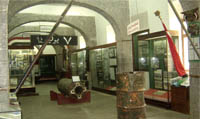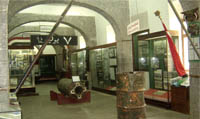
The Military Museum (Part 3 of 3)Yemen’s great history and heritage [Archives:2007/1052/Last Page]
May 21 2007
 |
fatimafnfr@yahoo.com
Journeying through Yemen's Military Museum in Sana'a, this series of articles will provide a general view of Yemeni civilization from both national and military history. This series will be published gradually, according to the order of the museums' halls.
Imam Ahmad bin Yahya and his people called him the devil, “Iblis,” because whenever the imam imprisoned him – which he did several times – he would suddenly disappear. Sa'eed Hassen Faria' is one of Yemen's freedom fighters who tried to assassinate Imam Ahmad in Lahj governorate's Al-Sakhina region. He was clever at planning plots to kill the imam and when caught by the imam's soldiers, he easily escaped and continued his activities against the Imamate rule.
The new Free Yemeni Movement was established to oppose the Imamate rule via demonstrations and distributing pamphlets. In 1961, a group of Yemeni freedom fighters showered Imam Ahmad with gunfire, injuring him seriously. After this incident, he was bedridden for eight months until he died.
September 26 Revolution Hall
The fifth hall, known as the September 26 Revolution Hall, depicts the combining of the Yemeni and Egyptian armies to fight Yemen's Imamate rulers. Many Egyptian soldiers made lofty sacrifices to usher in the Yemeni Revolution on Sept. 26, 1962 in North Yemen. A Yemeni and Egyptian statue and a photo of Egyptian President Gamal Abdul Nasser's visit to Yemen are some of the evidences displayed in the hall regarding Yemen's strong relations with Egypt at that time.
Just a year after the September 26 Revolution in 1962, Yemeni freedom fighters in South Yemen waged the October 14 Revolution in 1963 against British occupation there. At that time, South Yemen was divided into independent kingdoms.
There are photos of suppressive acts by the British against Yemenis during their occupation of the south; however, centered atop Radfan and Sarah Mountains and in several other regions, the Yemeni army forced the British out of Yemen.
The 70-day Siege Hall
Returning to North Yemen, there was a 70-day siege in Sana'a after establishing the republic system in Yemen. Several leaders from the areas around Sana'a kingdoms attacked Sana'a in an attempted coup to topple the authority. In the museum's seventh hall is a map describing all of the fighting in Sana'a during this siege.
During this difficult period, both the Yemeni nation in the north Yemen and their armies united to fight the kingdom leaders' attack and after 70 days, they broke the leaders' blockade of Sana'a.
May 22 Hall
The eighth hall, known as May 22 Hall, depicts Yemen's modern history, featuring its most important and greatest event – the reunification of North and South Yemen.
Many ancient narratives assert that Yemen was united long ago before it ever split into North and South; it previously had been one nation long ago. However, for historical reasons, it divided into two parts. Fortunately, on May 22, 1990 North and South Yemen reunited for the second time.
Numerous agreements were inked outside of Yemen between the two leaders of the two Yemens. Agreeing to merge their two armies, they finally signed a unification document on May 22 and the flag of united Yemen rose high over all Yemeni skies.
A barrel that had been used as a roadblock and a border between North and South Yemen was removed that day and families in the both parts gathered again.
Four years later, dissenters attempted to sever this unity by inciting secession; however, Yemeni citizens were determined to maintain their unity at any cost. The eighth hall regarding Yemeni reunification displays several photos from the miserable events of this 1994 Civil War, as well as the Yemeni nation's participation with the army to bring food to armed forces during the war.
In this final installment of this series, there are three more halls in the museum specialize in depicting the development of the Yemeni army, the Ministry of Interior and the Special Forces, as well as gifts President Ali Abdullah Saleh, ministers of defense and army leaders have received from both Arab and foreign world leaders.
——
[archive-e:1052-v:15-y:2007-d:2007-05-21-p:lastpage]


